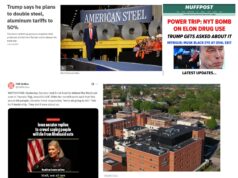See below for the latest, very helpful and appreciated “Friday Night Update from the ER in Arlington, VA” by Dr. Mike Silverman
My first week back from vacation is always hard. I had a lot of clinical time this week and the usual admin meetings, plus post vacation catch up. Therefore, this should be a quick read, so I don’t think you need to grab a drink before you start reading.
Our inpatient hospital COVID census (the number of patients hospitalized with COVID) has actually declined a bit since last week. That’s great and bucks the national trend. On the ER side, for the third week in a row, about 10% of our patients are coming in are requiring our “covid isolation” status. Not all of these patients will have COVID but it’s a decision we make early in their ER evaluation as a way to keep staff and visitors safe. It’s also something we’ve been tracking since the very beginning so can serve to see what our potential COVID volume is like. Certainly, the last 3 weeks had more patients in this category than the preceding weeks. We are diagnosing more patients with COVID week over week in both our symptomatic and asymptomatic patient categories. Our percent positive rate continues to increase as well. The asymptomatic patients are interesting as these patient present for things like heart attacks, hip fractures, and psychiatric illness and receive screening test. A positive screening test is typically a surprise for us. Increasing numbers and positivity rates are certainly consistent with national trends. I worked last evening. The COVID patients I saw or was aware of were unvaccinated. And among the patients in the hospital, many are critically ill. But we’ve admitted vaccinated patients, too. Our primary care offices report an increase in the number of requests for telehealth visits related to COVID symptoms. The COVID virus is not done with us even if we’re all done with it.
For those wondering, it’s still really bad in the south. Hospitals are full. ICUs are full. It’s hard for the healthcare workers to find beds for all of their sick people. I’ve heard rumors that our hospital team has been called to take patients from as far away as Texas. In all my years doing this, I’ve never heard a rumor like that.
Good news along the booster front. We knew they were coming at some point and we’re that much closer to making it official. We’ve learned that immunity wanes over time. We expected that and knew a booster was coming. We also know that Delta is a bit of a game changer so we need a higher antibody level to protect us.
I’ve been asked about getting the same brand of vaccine we got the first time, if we should claim immunosuppression and get it early, and the overall timing. First, the discussion is about the mRNA vaccines. J&J is submitting data in the near future but I wrote last week that initial data shows good immunity. We’ll have more details about J&J in a few weeks. For mRNA vaccines, it’s recommended that you receive the same vaccine you initially received. This is how they studied it so it’s the obvious answer. I’ve seen some discussion about getting the opposite one to enhance a response but this is pure speculation. Studies are underway to assess immune response so I wouldn’t worry if I got the other one, but for now, plan on getting the same one you initially received. Getting a booster based on immunosuppression is done on an honor system. If you’re desperate for a booster, from what I can tell, it’s possible. Just lie on the registration form. I don’t recommend that and don’t think it’s necessary. If you are immunosuppressed, please get your booster. The timing of the booster at 8 months is based on science and waning immunity. And the good news is that the highest risk groups such as healthcare workers, nursing home residents, and elderly, are coming up on the 8 month mark and will be able to get vaccinated in the near future. I think my 8 month mark is September 6th and boosters are expected to start the week of the 20th. It appears that some of the decision to push boosters is based on the data out of Mayo that we discussed last week. In this study, it shows that vaccine effectiveness in preventing disease decreased dramatically in July when Delta became the dominant variant. Of course, officially before this happens, the FDA has to review it and then it goes to the CDC Advisory Committee on Immunization Practices (ACIP) for final approval.
The other big news out of the CDC that pushed the booster discussion, came in their MMWR published earlier this week looking at vaccine efficacy in New York comparing data from May 3rd to July 25th. Although vaccine effectiveness against severe illness and hospitalization remained very good (>90%), effectiveness against infection declined from 91.7% to 79.8%. One of the interesting data points to come out of the analysis was the number of new cases comparing vaccinated to unvaccinated populations. Between May 3rd-July 25th, new cases among fully vaccinated people were “1.31 per 100,000 person-days compared to 10.69 per 100,000 person days among unvaccinated adults.” That’s a substantial difference. Breaking down the vaccinated effectiveness by age showed the following: “90.6% to 74.6% for persons aged 18–49 years, 93.5% to 83.4% for persons aged 50–64 years, and 92.3% to 88.9% for persons aged ≥65 years.” All of this is consistent with what we’ve seen previously. The vaccine prevents hospitalization and death. Delta causes more breakthrough infections. Immunity wanes over time (seen in the UK and Israel—see previous posts for details). The booster should help prevent Delta infections in vaccinated people, boost the waning immunity that occurs with time, and will help maintain the high rates seen in preventing severe illness and death.
There’s some interesting data out of LA County. Currently, fully vaccinated people represent about 20% of new cases (this number is consistent around the country). However, in LA, this is up from 11% in May, 5% in April, and 2% in March. We’re clearly seeing more breakthrough cases. When looking at hospitalizations in California, there have been 1615 breakthrough infections requiring hospitalization. This represents only 0.007% of the 22 million vaccinated citizens of the state (reported by the New York Times). The vaccine really does a great job of preventing severe illness and death.
With this post, I’ve exceeded 100,000 words in my Friday night updates. I’m not sure how to put that in perspective but it seems like a lot. I appreciate all of you who have enjoyed reading these posts and find them valuable.
I’ve had to adjust my last line. I switched to “we’re almost there” a few months ago. We’re not as close to the end as I thought we were earlier this summer.
Science matters. Get vaccinated. Wear a mask when you’re supposed to. We’re not quite there.
Mike




![Thursday News: “World leaders now enter the White House at their own risk”; “2 Israeli Embassy staff shot and killed in front of Capital Jewish Museum in DC”; GOP Moves to Pass “Monstrous” Bill Which “steal[s] from the poor and give[s] to the rich”](https://bluevirginia.us/wp-content/uploads/2025/05/montage0522-238x178.jpg)








![[UPDATED with Jim Ryan’s Letter] In Response to Youngkin’s “Sad, Whiny” Letter to Spanberger About UVA, VA Senate Majority Leader Surovell Says He’s “truly embarrassed for Gov Youngkin…After 4 yrs he has no understanding of basic VA govt structure”](https://bluevirginia.us/wp-content/uploads/2025/11/youngkinspanuva3-100x75.jpg)